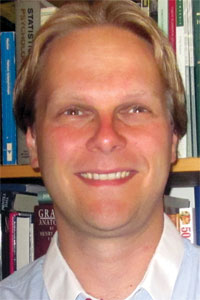Lauri Nummenmaa

Aalto University, Finland
What does your research focus on?
I study the brain basis of emotions and social cognition. Using the multimodal brain-imaging approach, I aim to understand the neural circuitry that enables us to navigate the social and physical world unharmed. In particular, I am interested in how the brain automatically processes the emotional and social cues conveyed by other people, and how this enables our brains to tune our behavior and mental processes to manage, for example, social interactions.
What drew you to this line of research? Why is it exciting to you?
I simply stumbled upon brain imaging. One day my PhD supervisor mentioned that it is possible to do fMRI at the University hospital and that we could give it a go. I thought that it was an exciting idea, so we went ahead and conducted an fMRI study on eye-gaze following. We had to learn lots of things ourselves and only afterwards found out that our study was actually the first successful fMRI experiment ever done at the site. If I had known that in advance, I would probably never have dared to begin working on that project! But ever since I have loved studying brain function. The brain is an unbelievably complex organ that governs intricate psychological and behavioral processes. And when you bring two or more people into the same room, you suddenly have brains that are communicating with each other and interpreting the expressions, gestures, and vocalizations of the other person. This astonishing feat never ceases to amaze me.
Who were/are your mentors or psychological influences?
I have been lucky, as I have had numerous outstanding supervisors and collaborators during my career. My PhD supervisor Jukka Hyönä of the University of Turku had a wonderful habit of casually using the Socratic method to encourage us students to think critically. His office door was always open, and he was always excited to see and discuss the new data we had acquired. During my postdoc at MRC CBU, Andy Calder introduced me to the neuroscience of face perception, and while working with his group, I really learned the nuts and bolts of functional neuroimaging. At the moment, I feel privileged to be able to work with scientists such as Riitta Hari and Mikko Sams at the Aalto University; they constantly bombard me with great ideas and novel ways of thinking, so every day at the lab is really exciting.
To what do you attribute your success in the science?
During my career, I have had wonderful mentors and labmates who have provided both top-class training in scientific thinking and emotional support during hard times. So I have really learned to value my ‘academic family’ and think that great science is made by successful teams rather than by successful individuals.
What’s your future research agenda?
I want to understand the organization and dynamics of the brain networks that processes social and emotional signals under naturalistic conditions. Although rigorously controlled laboratory experiments are the backbone of neuroscience, they often fail to encompass the sensory and psychological complexity of our daily lives. That is why we are measuring brain function while, for example, viewing complex prolonged stimuli such as Hollywood feature films or during two-person interaction. This approach poses huge technical as well as computational challenges. Luckily, we have collaborators and clever PhD students who are extremely skilled in signal analysis. Without them this line of work would never be possible.
Any advice for even younger psychological scientists? What would you tell someone just now entering graduate school or getting their PhD?
Have fun! Although science is serious business, it should never be boring. So choose a topic that you feel excited about, and try to find a research group that you feel comfortable with. Also, when planning your work, try to focus on big questions. Design every single study so well that it could at least in principle be published in one of the top journals. Of course, only a fraction of papers will eventually be published in Nature or PNAS (none of mine have been!), but if you aim there, you force yourself to raise the bar and end up with good psychological science.
What publication are you most proud of or feel has been most important to your career?
Nummenmaa, L., Hyönä, J., & Calvo, M. G. (2010). Semantic categorization precedes affective evaluation of visual scenes. Journal of Experimental Psychology: General, 139, 222-246.
This was the final piece of a long series of behavioral studies on visual emotional processing that we started during my PhD work. It tackles the classic question of the primacy of cognitive versus emotional processing in the visual system. I think this paper is a nice example of “slow science.” With seven experiments, countless controls, and different paradigms and stimulus sets, I feel we could really provide a conclusive answer to the question we posed.





APS regularly opens certain online articles for discussion on our website. Effective February 2021, you must be a logged-in APS member to post comments. By posting a comment, you agree to our Community Guidelines and the display of your profile information, including your name and affiliation. Any opinions, findings, conclusions, or recommendations present in article comments are those of the writers and do not necessarily reflect the views of APS or the article’s author. For more information, please see our Community Guidelines.
Please login with your APS account to comment.